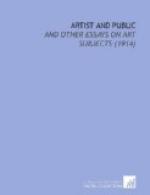Under the conditions of to-day there are no longer anywhere such distinctive local schools as existed in the Renaissance. In Italy, in those days, there were not only such great schools as the Venetian, the Florentine, and the Umbrian, differing widely in their point of view, their manner of seeing, and their technical traditions—each little town had a school with something characteristic that separated its painters from those of other schools in the surrounding towns. To-day every one knows and is influenced by the work of every one else, and it is only broad national characteristics that still subsist. Modern pictures are singularly alike, but, on the whole, it is still possible to tell an English picture from a French one, and a German or Italian picture from either. We may still speak of a Dutch school or a Spanish school with some reasonableness. Is it similarly and equally reasonable to speak of an American school? Does a room full of American pictures have a different look from a room full of pictures by artists of any other nationality? Does one feel that the pictures in such a room have a something in common that makes them kin and a something different that distinguishes them from the pictures of all other countries? I think the answer must be in the affirmative.
We have already passed the stage of mere apprenticeship, and it can no longer be said that our American painters are mere reflections of their European masters. Twenty or even ten years ago there may have been some truth in the accusation. To-day many of our younger painters have had no foreign training at all, or have had such as has left no specific mark of a particular master; and from the work of most of our older painters it would be difficult to guess who their masters were without reference to a catalogue. They have, through long work in America and under American conditions, developed styles of their own bearing no discoverable resemblance to the styles of their first instructors. To take specific examples, who would imagine from the mural paintings of Blashfield or the decorations by Mowbray in the University Club of New York that either had been a pupil of Bonnat? Or who, looking at the exquisite landscapes or delicate figure pieces of Weir, would find anything to recall the name of Gerome? Some of the pupils of Carolus Duran are almost the only painters we have who acquired in their school-days a distinctive method of work which still marks their production, and even they are hardly distinguishable to-day from others; for the method of Duran, as modified and exemplified by John Sargent, has become the method of all the world, and a pupil of Carolus simply paints in the modern manner, like the rest. Those American painters who have adopted the impressionist point of view, again, have modified its technic to suit their own purposes and are at least as different from the Impressionists of France as are the Impressionists of Scandinavia. We have painters who are undeniably




